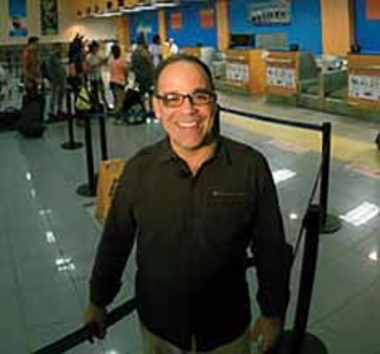Airlines race to Cuba, overcoming major hurdles

(Havana) — Galo Beltran stands on the tarmac testing a hand-held baggage scanner. Each time a barcode is successfully read, he smiles.
The device, which is used to track luggage, is deployed at airports across the world. But until this moment, Beltran wasn't sure if it would work on Cuban cellular networks.
As satisfying as meeting that challenge was, there are hundreds more to be tackled as U.S. airlines prepare to resume their first regularly scheduled flights to Cuba in five decades. Collecting baggage fees in a country where most U.S. credit cards don't work, for instance. And solutions need to be found rapidly — airlines must start flights within three months of being granted a route by the U.S. government.
"We have a good plan in place," says Beltran, a longtime American executive who is overseeing the airline's entrance into Cuba. "Even with the challenges, we have been able to look for loopholes."
The Department of Transportation granted American and five other airlines permission to fly to nine Cuban cities. Normally, airlines spend up to a year preparing for new foreign markets. In this case, flights must start within 90 days of the government awarding the route. A decision is expected later this summer on the more-coveted — and contested — routes to Havana.
Teams from American and JetBlue Airways have already visited Cuba. American leads the group, flying 1,084 charter flights last year, followed by JetBlue with 221.
When flying the route on behalf of a charter company, the airlines don't have to worry about selling tickets, dealing with currency or many of the logistical challenges. But all of that becomes the airlines' responsibility once they start scheduled service.
The charter experience has provided some lessons on serving Cuba. But much is still unknown.
"With Cuba, we can't look at what other U.S. carriers have done," says Scott Laurence, senior vice president of airline planning at JetBlue. "We know we've got to be ready for a number of curveballs."
Most Americans cannot still legally visit Cuba. However, the Obama administration has eased rules to the point where travelers are now free to design their own "people-to-people" cultural exchange tours with very little oversight. But airlines still need to record — and keep for five years — the official reason why somebody is traveling to Cuba. So reservation systems have been revamped to allow passengers to select one of the 12 permitted categories. They include family visits, official business, educational or religious activities.
U.S. citizens' interest in visiting Cuba has swelled since relations between the two nations started to thaw in December 2014. Nearly 160,000 U.S. leisure travelers flew to Cuba last year, along with hundreds of thousands of Cuban-Americans visiting family.
That's only likely to grow following an aviation agreement signed between the two nations in February that allows for up to 110 daily scheduled flights — more than five times the current charter operations.
Many travelers are excited for the change. Charters are often expensive and lack online booking or 24-hour customer service.
Hilda Costa and her husband Larry Costa of Wappingers Falls, New York, recently took a charter from New York to Havana to visit her family. "When you go through the travel agencies, it's a lot of money that they charge you," she says. "I can't wait for the day they have regular airline service."
Costa paid $859 a person, not including luggage fees: usually $25 a bag plus $2 or $3 for each pound over 44 pounds.
Cuba has already seen startling growth in aviation. Last year, 18 percent more passengers flew there than in 2014, according to government aviation officials.
Currently, 46 airlines fly to Cuba including Air France, Aeromexico, KLM, Air Canada, Aeroflot and Iberia. But none of them fly from countries that still have a trade embargo with Cuba. Now, thanks to an easing of regulations under the Obama administration, U.S. airlines are about to add to that mix.
Cuban aviation officials say they are ready for the extra flights but questions remain.
Everywhere Beltran went last week, he reminded Cuban officials of American's message: "We have kept our commitment of serving Cuba for 25 years nonstop." And told them that American would prefer to use the updated terminal.
"We will see," Martinez says of the terminal request. "There will always be somebody who isn't happy."
By Scott Mayerowitz, AP Airlines Writer. Copyright 2016 The Associated Press.
The Gayly – July 25, 2016 @ 12:40 p.m.





